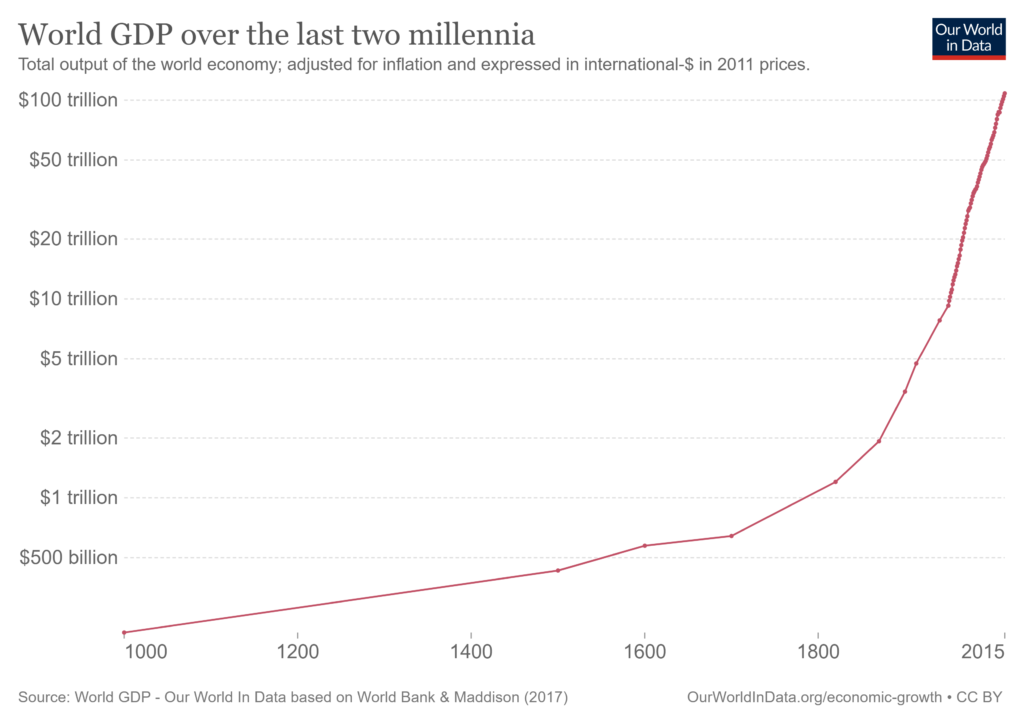The May 1 post on freight flows includes, “More has been normal — not always year-over-year, but consistently decade-over-decade.” Not for everyone, not everywhere, but by the early 18th Century the experience of more and more was widening and accelerating. Please see chart below. Since the mid 20th Century our planet’s economic output has recorded exponential rates-of-change.
Given the outcome of three-plus centuries, the expectation of more is not unreasonable. Especially since 1950, failure to lean-into anticipation of more would have been delusional. (Despite early, earnest warnings of an eventual slow-down.) The growth of effectual demand and real output has been persistent. I perceive it has also been precipitous (meaning steep, sudden, and potentially dangerous).
This rate-of-change has, of course, prompted profound consequences: economic, social, cultural, ecological, and from almost any other angle. Since 1950 the planet’s population has increased from 2.5 billion to more than 7.9 billion while the proportion “living in poverty” has declined. Just since 1990 those living in extreme poverty has declined from over one-third to less than one-tenth of total population. Much more has been much better for millions.
We are also increasingly aware of the trade-offs — and potential limits — of more and more (here and here and here).
Explosive demand has generated revolutionary changes in scope, scale, and methods of supply. Given population growth and even faster growth in demand, change has been necessary. When changes are effective, they have usually been profitable. In the 1980s Walmart demonstrated how to deliver more for less. Walmart, Amazon, and many others continue to compete by delivering even more for relatively less. Supply chain design and execution is a source of crucial competitive advantage.
Recognizing the trade-offs and limits of living on our current precipice, there are ambitious efforts underway to better sustain the ability to deliver more for less… including fewer long-term climate impacts (here and here and here). So far, supply chain sustainability and resilience seem to be compatible traveling companions. (It is, however, complicated.)
But in some places more is, arguably, no longer needed. According to Reuters, “Last year Italy recorded more than 12 deaths for every seven births and the resident population fell by 179,000 to 58.85 million… Italy could lose almost a fifth of its residents, with the population set to decline, under a baseline scenario, to 54.2 million in 2050 and 47.7 million in 2070.” The Japan Times reports, “Japan’s population shrank by 556,000 in 2022 from a year earlier to 124.9 million, marking the 12th straight year of decrease.” China’s demand will increase as per capita wealth increases. But in 2022 the population of China began what is expected to be a long-term decline (more). In most of the world’s wealthiest places, population growth is slowing or reversing.
Where and when population declines, demand for volume tends to follow. But there is evidence — already observed in Italy and Japan — that as volume becomes less exacting, velocity may become more valuable. Speed — both fast and, when appropriate, slow — becomes a key competitive differentiator. So does specific direction, both in terms of time and place and/or personal preferences and perceived value. For many consumers, quantity advantages (including related volume pricing) defer to aspects of quality… with profound implications for the production, distribution, and consumption of goods and services.
